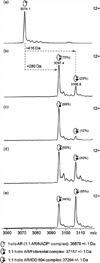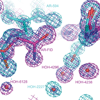Crystal packing modifies ligand binding affinity: the case of aldose reductase
- PMID: 22752989
- PMCID: PMC4671318
- DOI: 10.1002/prot.24136
Crystal packing modifies ligand binding affinity: the case of aldose reductase
Abstract
The relationship between the structures of protein-ligand complexes existing in the crystal and in solution, essential in the case of fragment-based screening by X-ray crystallography (FBS-X), has been often an object of controversy. To address this question, simultaneous co-crystallization and soaking of two inhibitors with different ratios, Fidarestat (FID; K(d) = 6.5 nM) and IDD594 (594; K(d) = 61 nM), which bind to h-aldose reductase (AR), have been performed. The subatomic resolution of the crystal structures allows the differentiation of both inhibitors, even when the structures are almost superposed. We have determined the occupation ratio in solution by mass spectrometry (MS) Occ(FID)/Occ(594) = 2.7 and by X-ray crystallography Occ(FID)/Occ(594) = 0.6. The occupancies in the crystal and in solution differ 4.6 times, implying that ligand binding potency is influenced by crystal contacts. A structural analysis shows that the Loop A (residues 122-130), which is exposed to the solvent, is flexible in solution, and is involved in packing contacts within the crystal. Furthermore, inhibitor 594 contacts the base of Loop A, stabilizing it, while inhibitor FID does not. This is shown by the difference in B-factors of the Loop A between the AR-594 and AR-FID complexes. A stable loop diminishes the entropic energy barrier to binding, favoring 594 versus FID. Therefore, the effect of the crystal environment should be taken into consideration in the X-ray diffraction analysis of ligand binding to proteins. This conclusion highlights the need for additional methodologies in the case of FBS-X to validate this powerful screening technique, which is widely used.
Copyright © 2012 Wiley Periodicals, Inc.
Figures








Similar articles
-
X-ray structure of the V301L aldo-keto reductase 1B10 complexed with NADP(+) and the potent aldose reductase inhibitor fidarestat: implications for inhibitor binding and selectivity.Chem Biol Interact. 2013 Feb 25;202(1-3):178-85. doi: 10.1016/j.cbi.2012.12.013. Epub 2013 Jan 4. Chem Biol Interact. 2013. PMID: 23295227
-
Subatomic and atomic crystallographic studies of aldose reductase: implications for inhibitor binding.Cell Mol Life Sci. 2004 Apr;61(7-8):763-73. doi: 10.1007/s00018-003-3404-1. Cell Mol Life Sci. 2004. PMID: 15095001 Free PMC article. Review.
-
A potent aldose reductase inhibitor, (2S,4S)-6-fluoro-2', 5'-dioxospiro[chroman-4,4'-imidazolidine]-2-carboxamide (Fidarestat): its absolute configuration and interactions with the aldose reductase by X-ray crystallography.J Med Chem. 2000 Jun 15;43(12):2479-83. doi: 10.1021/jm990502r. J Med Chem. 2000. PMID: 10882376
-
Ligand-induced fit affects binding modes and provokes changes in crystal packing of aldose reductase.Biochim Biophys Acta. 2011 Sep;1810(9):879-87. doi: 10.1016/j.bbagen.2011.06.001. Epub 2011 Jun 13. Biochim Biophys Acta. 2011. PMID: 21684320
-
Strategies for the design of inhibitors of aldose reductase, an enzyme showing pronounced induced-fit adaptations.Cell Mol Life Sci. 2004 Apr;61(7-8):783-93. doi: 10.1007/s00018-003-3406-z. Cell Mol Life Sci. 2004. PMID: 15095003 Free PMC article. Review.
Cited by
-
Cryo-EM for Small Molecules Discovery, Design, Understanding, and Application.Cell Chem Biol. 2018 Nov 15;25(11):1318-1325. doi: 10.1016/j.chembiol.2018.07.006. Epub 2018 Aug 9. Cell Chem Biol. 2018. PMID: 30100349 Free PMC article. Review.
-
Structural and Kinetic Studies of Formate Dehydrogenase from Candida boidinii.Biochemistry. 2016 May 17;55(19):2760-71. doi: 10.1021/acs.biochem.6b00181. Epub 2016 May 3. Biochemistry. 2016. PMID: 27100912 Free PMC article.
-
Comparison of Data Fusion Methods as Consensus Scores for Ensemble Docking.Molecules. 2019 Jul 24;24(15):2690. doi: 10.3390/molecules24152690. Molecules. 2019. PMID: 31344902 Free PMC article.
-
A conformational landscape for alginate secretion across the outer membrane of Pseudomonas aeruginosa.Acta Crystallogr D Biol Crystallogr. 2014 Aug;70(Pt 8):2054-68. doi: 10.1107/S1399004714001850. Epub 2014 Jul 25. Acta Crystallogr D Biol Crystallogr. 2014. PMID: 25084326 Free PMC article.
-
Probing the Surface of a Parasite Drug Target Thioredoxin Glutathione Reductase Using Small Molecule Fragments.ACS Infect Dis. 2021 Jul 9;7(7):1932-1944. doi: 10.1021/acsinfecdis.0c00909. Epub 2021 May 5. ACS Infect Dis. 2021. PMID: 33950676 Free PMC article.
References
-
- Danley DE. Crystallization to obtain protein-ligand complexes for structure-aided drug design. Acta Crystallogr D Biol Crystallogr. 2006;62(Part 6):569–575. - PubMed
-
- Rondeau J, Klebe G, Podjarny A. Ligand binding: the crystallographic approach. In: Podjarny A, Dejaegere A, Kieffer B, editors. Biophysical approaches determining ligand binding to biomolecular targets: detection, measurement and modelling. modelling. Vol. 1: Biomolecular sciences. London: RSC Publishing; 2011. pp. 56–135.
-
- Blundell TL, Jhoti H, Abell C. High-throughput crystallography for lead discovery in drug design. Nat Rev Drug Discov. 2002;1:45–54. - PubMed
-
- Skarzynski T, Thorpe J. Industrial perspective on X-ray data collection and analysis. Acta Crystallogr D Biol Crystallogr. 2006;62(Part 1):102–107. - PubMed
-
- Cimmperman P, Matulis D. Protein thermal denaturation measurements via a fluorescent dye. In: Podjarny A, Dejaegere A, Kieffer B, editors. Biophysical approaches determining ligand binding to biomolecular targets: detection, measurement and modelling. Vol. 1: Biomolecular sciences. London: RSC Publishing; 2011. pp. 247–274.
Publication types
MeSH terms
Substances
Grants and funding
LinkOut - more resources
Full Text Sources
Research Materials

